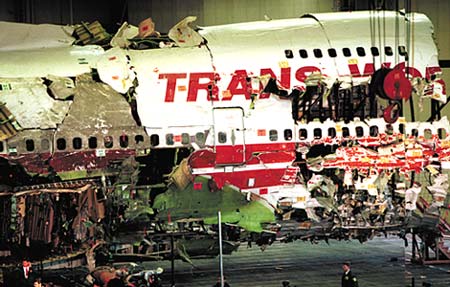Dec. 97: FAA Moves On TWA 800-Related ADs
from Aero Safety & Maintenance, Dec. 12, 1997
18-Aug-2000 10:13 AM U.S. EDT

FAA last week proposed two airworthiness directives aimed at potential ignition sources in or near the center fuel tanks of Boeing 747 aircraft, just as the National Transportation Safety Board was gearing up for this week's investigative hearings in Baltimore on the crash of TWA Flight 800.
Tom McSweeny, director of aircraft certification, said the ADs are based on recent tests conducted by the National Transportation Safety Board but are "precautionary in nature. There is no evidence yet that either one of these ADs is linked to the cause" of the Flight 800 crash.
The first AD has a 12-month compliance deadline for all 747s except the Series 400 and will require installing components to suppress electrical transients and/or installation of wire shielding and separation of the Fuel Quantity Indication Systems from other wiring. FAA estimated the cost of this AD at $13,200 per aircraft.
Recent tests showed that higher-than-expected induced voltage spikes were possible when the lower voltage FQIS wiring was placed next to higher- voltage, high-current wires, FAA said. Induced voltage is created through electromagnetic interference when the higher-current flow is suddenly shut off. Post-accident inspections found metal contamination in some fuel tanks that could lodge in the probes and cause a short circuit, the agency said. If the contamination is present when the higher induced voltage is present, a spark could be created in the fuel tank.
"The sparking raised by a combination of an EMI surge and probe contamination makes it prudent" to protect the wires, FAA said. "We saw as high as 800 volts induced," McSweeny said. But "without contamination, you do not have a spark."
The second AD will require immediate inspection of the scavenge pump wiring on older 747s to detect deterioration of insulating materials in electrical connectors and replacement within 90 days of pumps with silicone insulating materials.
The scavenge pump removes leftover fuel from the tank, and a pump removed by the NTSB from the TWA 800 crash revealed that some connectors use a silicone insulating material incompatible with the fuel used to cool and lubricate the scavenge pump motor. FAA said this could cause a breakdown of the insulating material, resulting in a fuel leak through the pump connector into the main landing gear wheel well, which could cause a fire. FAA estimated the cost of inspecting the scavenge pump at $60 per aircraft.
A total of 979 Boeing 747s worldwide are affected by the ADs, FAA said.
Meanwhile FAA is beginning to move away from the traditional theory of eliminating sources of ignition, and is considering the NTSB current position that the possibility of explosive fuel/air mixtures should be eliminated from transport aircraft. A committee of the Aviation Rulemaking Advisory Committee (ARAC) is being directed to identify ways to reduce the potential for explosions in fuel tanks. Current methods under consideration include control of fuel temperature, introduction of a fuel tank inerting medium, such as nitrogen, and explosion suppression systems.